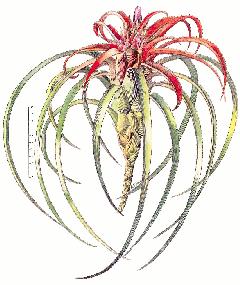
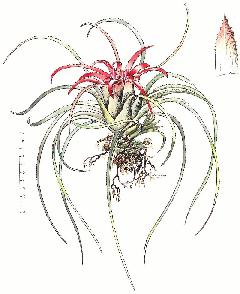
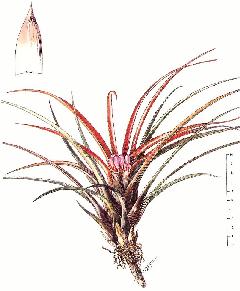
Click on thumbnails for full image.
September meeting from the Secretary’s desk
We gave Len Colgan the chance to speak first about the plants on display. These were dominated by Tillandsias but there were a couple of interesting discussions. First was a plant called Neoregelia macwilliamsii which Len considered was a N. compacta. Therein lies the discussion. Neither plant is easy to grow in Adelaide because it wants to flower in our winter, and I have just now thrown out a challenge to Queenslanders. You see, both these plants are very similar except for size. The very big ones are identified as N. macwilliamsii and the small ones as N. compacta. The problem is that there are several plants which are somewhere in between. Whether they take up my challenge to butcher a few flowering plants in the cause of science is another matter, but I find it intriguing.
XCryptbergia rubra. It is interesting how names stick and do not change. Everybody knows that a hybrid does not have a Latinised name other than the genus. It is nearly 20 years ago that its name was changed to ‘Red Burst’. It is a plant that was very common when this Society was formed and only seems to raise its head on odd occasions. If anyone has its photo when in flower I would be very pleased to say ‘Thank You’!
Two large potted Tillandsias in flower were on display which had to be recorded in the memory bank because both are terminal flowerers in the true sense of the word under Adelaide conditions. One, Tillandsia parryi may set seed but the other T. guatemalensis you just need to make a trip to Melbourne because they grow like weeds there!!
I was very intrigued with Len’s T. duratii with the dirty yellow flowers. It was still scented and completely different from the normally blue petals. I have yet to have a sensible discussion with the insects who pollinate these sorts of Tillandsia. I know it is the insects I should be speaking to because there is no red to attract birds. Primarily it must be scent that attracts them but what colour do they prefer? I prefer blue but dirty yellow may be their thing.
And so to the Bill and Derek Show on Aechmea recurvata. First we had a bit of botany where a few people were given line drawings so they could tell the botanical differences between the 3 varieties. We knew that nobody had the variety albobracteata which although found in the wild in 1989 was not named until 2004.
These are shown below so you can follow the key



Key to the Varieties of Aechmea recurvata
1. Inflorescence completely exserted above the leaf -sheaths; floral bracts serrate.
var recurvata.
2. Inflorescence almost or wholly included by the leaf-sheaths.
2a. Leaves and bracts strongly serrate. var ortgiesii.
2b. Leaves and bracts entire or nearly so. var benrathii.
The hardest thing seemed to be in deciding when the inflorescence exceeded the leaf sheaths. This was especially so where we had a plant from Victoria where someone had crossed var. recurvata with var. ortgiesii! There were several hybrids on display where we could point out identification clues. There are 81 hybrids listed that have Aechmea recurvata in them somewhere and in almost every case you can pick the involvement showing that it is a dominant partner!
There were some interesting plants coming out of the woodwork that needed investigation. One was from Queensland with the name Aechmea ‘Karamea Topsy’ which we thought strange because this name has links with New Zealand! Peter Franklin from Raymond Terrace, NSW and I had discussed this New Zealand plant because it seemed to be linked to the Australian ‘Blue Bonnet’ a plant of dubious origins and variability but that was about all. Identifying unnamed cultivars is fraught with danger and one of the best ways of confirmation is by following leads as to where the plant originated. These days it is easy to identify a plant from a photo on the Cultivar Register but easy to misidentify too. I have a feeling it is what has happened in this case with the enquirer not looking for the comment of the link to the Aussie ‘Blue Bonnet’.
Aechmea ‘Suave’ was one that has links to benrathii although how different seems debateable. However, there is a clone ‘wandering’ around that needs to be formally identified. As such, Adam is on a promise the photo the plant when next in flower.
Aechmea ‘Yellow Throat’ is an odd name for a plant and one that I did have for some time. When coming into flower the inflorescence is down in the leaf rosette and is yellow at that stage. My plant never actually flowered so I considered it a mule and threw it out. Maureen says hers has flowered so if there is anyone who can substatiate her claim, please come forward.
Adam had brought in a xNeomea (‘Fireball’ x recurvata). I never like these formula names because it means the hybridist did not consider his/her hybridising worthy of an identification Cultivar name. In this case discussions are occurring in the Eastern States as to whether this is the same as ‘Shooting Star’ where the owner of both plants has been been growing them side by side for several years and cannot tell them apart. You never know, we may be able to solve this puzzle.
And now to another puzzle. If a hybridist hybridises and has too much seed and sends such seed around you can expect trouble. In the 1980’s Grace Goode crossed A. recurvata var. benrathii with A. orlandiana and called the plants Aechmea ‘Big Ben’. When Don Beadle was compiling the 1998 Cultivar Register, Grace considered that the plants that she kept did not warrant the name because there was very little difference between the seedlings and A. recurvata var. benrathii, and so the name was dropped. In 2004 I found the plant was in New Zealand with distinct links to the pollen parent in the leaves and they had a photo, so the name was put into the Cultivar Register. At our meeting we had an Aechmea ‘Big Beauty’ which looked like ‘Big Ben’. We found out that Maureen Hick had been one to receive seed from Grace only she had called her plants ‘Big Beauty’. So that you do not have to change your label from ‘Big Beauty’ to ‘Big Ben’ I will make a note in the Cultivar Register as to their relationship.
October meeting from the Secretary’s desk
Len Colgan spoke on the plants on display.
Adam had brought in several Vrieseas in spike for Len to drool over. He was also surprised to see a strong growing Aechmea carvalhoi and yet this seems to like being in Adelaide. We don’t often see a flowering Quesnelia indecora but it was interesting to see how little different it is from Billbergia. Many of the Quesnelias have moved from genus to genus over the years where taxonomists saw slight differences that they considered significant. Current studies in Brazil have shown that there are more changes in the wind.
XNeophytum ‘Galactic Warrior’ was at its brilliant best but as Maureen Hick pointed out it had lost its variegation! You can’t win them all!
Some of you may remember that several months ago Len Cork brought in a palm frond sheath, somewhat twisted and about 1m long. Nobody knew what to do with it except George Rudolph. We saw how he had mounted it and mounted tillandsias on it! Certainly different to George’s other artistic arrangements.
Those of you who bought some of Corky’s plants must be warned that Corky was not that accurate with his names. Some of you may have picked this fact up at discussions at past meetings. So, some of you will be on learning curves of various sharpnesses! Acquiring plants this way is no real hassle because you buy what you see. The problem comes later when you want a plant by name. As you know, I never trust the name on the label and get a warm fuzzy feeling when I work out a plant’s name. I recommend this warm fuzzy feeling to others!.
Colin Waterman brought in a Tillandsia fasciculata with goo in the inflorescence. He was more interested in the goo whereas I was more interested in the name! Bill Treloar was quite sure the plant had been kept on the dry side and coming from Bute he should know about such things. There are several vriesias and guzmanias known for their gooey flowers and there may be links to malfunctioning nectar glands. This is generally water soluble anyway so if you have a spare bucket of water! One way to tell a Tillandsia fasciculata is that its branches are fasciculate – like how your fingers extend from your palm. In other words roughly from the same point on the stem. T. rodrigueziana, ( true name for Colin Waterman’s plant ) on the other hand has a central stem where the branches branch off at intervals. The flat side of these branches are at right angles to the central stem.
There were several other tillandsias brought in with many flowering.
 Neoregelia olens painting.
Neoregelia olens painting.
It was great to see the number of Neoregelia olens and cultivars that had been brought in by a wide range of members. Keep up the good work! Derek and Bill had the honours with Derek doing the technical stuff and Bill on a more cultural note.
In 1865 Billbergia olens came into being having been at St Petersburg, in Russia for some time. In fact they sent a plant nine years earlier to Kew. We will never know if it flowered in Russia but it took some time at Kew! They found that growing it and flowering it with water in the cup causes the nectar to ferment! This was why they called it the ‘Putrid smelling Billbergia’. As an aside, I hope you never recommend the growing of a Neoregelia totally indoors through its flowering phase. You could well be in for a smelly surprise. Now you know why dogs absolutely adore a flowering Neoregelia that has too much water in the centre cup. Back to the Billbergia which we now know as Neoregelia olens – whether the actual flowers have a sweet scent I do not know. Perhaps some of our more adventuresome members may like to try to find out.
Not many people grew this species – perhaps the name put them off- and it was not until about the 1970’s that allied species started coming out of Brazil to the USA. As with so many collected plants that are not identified on collection they get various nicknames by resale nurseries. Certainly one ‘name’ that cropped up in California was 696 which was eventually linked to N. olens. In 1982 Margaret was the proud owner of a ‘696’ when we were on holiday in California. In 1983 Harry Luther wrote an article in Journal. Brom. Soc on Neoregelia in cultivation in the USA and said that 696 was linked with ‘Vulcan’. Grace Goode was growing a ‘Vulcan’ and her plant looked nothing like ours. Even then I was always asking questions so off I wrote to the BSI in the USA. Yet another name cropped up ‘Marie’ but at least we had a photo of it to show what to expect. All 3 are botanically Neoregelia olens and all had some spotting on the leaves - something not mentioned in the formal description! We had some examples to show members.
While I may grumble about these sorts of misnamings you can at least have fun trying to identify species because you have a description to follow. So even if you lose the label you can find out a correct name if you are prepared to go that extra yard in butchering a flower. This is impossible with hybrids as many of you will have found out already.
We also had a plant called Neoregelia aff camorimiana to show you which also looks like a Neoregelia olens. It had aff camorimiana on the label because that was what Harry Luther had advised us – an affinity with camorimiana. These are the sorts of plant we like to grow because it has ‘history’. It came to Australia in the 1970’s probably from Adda Abendroth but unnamed. Bill Morris had it for years and called it a ’pigmented olens’ but it also got around as ‘Bill’s Red’ and even as Neoregelia chlorosticta in Queensland. It must be ten years ago that felt I had to discuss this plant with Harry Luther. As is usual he sent me photocopies of his records and against detail about Neo. Camorimiana he had a succinct comment ?cf olens. So there is similarity and Bill Morris was not far out calling the plant ‘pigmented olens’!
N. olens is one of Margaret’s favorites but get a good looking species into the hands of hybridists and they will have an undefinable urge to hybridise it, whether it improves it or not.
These days of water restrictions we should be looking at growing species rather than hybrids if only for the sake of the world wide drive for plant conservation. Humans continue to multiply at an alarming rate and demand more and more land. It is becoming more and more accepted that one way to protect wild animals is in Zoo like environments. Plants do not get the same publicity as animals and are disappearing at an even faster rate! I am involved with the Bromeliad Conservation Strategy of the Bromeliad Society International lead by Pierre Ibisch, a German but known mainly for his conservation work in Bolivia. He tears his hair out trying to keep up with the problems of decisions and indecisions of the Bolivian Government. First we must encourage conservation of endemic plants but it is very difficult to tell a poor nation to do something where a rich nation like Australia has a poor record. To my mind, if we do grow Bromeliads we should try to grow species. It can be said that nature gives away plants to collectors but you have to buy hybrids. Money is the basis of our modern world and yet to me there is more worth in a plant that has taken nature hundreds of years to produce than one that has been produced by man in one to two years. Regrettably few see it my way but I’ll continue to push my views on the subject.
There were many hybrids on show and many you could pick out the influence of olens in their make-up. The exception seemed to be where carolinae or concentrica were involved and little could be seem of the influence of N. olens. This was even more noticeable in the Aussie Dream complex. I say complex because no cultivar has been registered under this name but the name persists where people have lost the original name tag.
When talking about culling for the best offsets Geoff Jarrett from Strathalbyn pointed out that he had a non-variegated offset occurring on his variegated plant. What should he do? My view was that if he wanted a variegated plant he should destroy this particular sport. When dealing with offsets you do not take all but select the best! This is especially so with variegates which can lose the intensity of the variegations and it pays to select for the better looking offset. A good example of this is Neo. ‘DeRolf’. We have had many requests for offsets from our plant that was at the March Show but regrettably it is a plant that often produces offsets without variegations. These are consigned to the rubbish bin because the non-variegated N. johannis is sufficiently available.
Neoregelia sanguinea by Derek Butcher
Not much is known about this plant in Australia but at the latter part of the 1990’s I was sent some seed by Antonio Miranda in Brazil. With any seed you need to be vigilant about accidental cross pollination with foreign pollen. So you may be advised it was from a wild plant but that plant may be in a collection or plant nursery. In this case I gave some seed to John Catlan of Queensland who was not that impressed with the result. My seedlings took a couple more years to mature! It is a large plant – up to 80cm diam – so I did not keep many, but all had a similarity. Not like an F2 grex. So they were either a species or an F1 hybrid. My first plant just had to flower in early winter so did not colour up as much as I would have liked. It is compared to both N. macwilliamsii and N. compacta which are both winter flowerers in Adelaide. But as usual, I took the flower to pieces and to my mind is very close to the description. Not many of you will subscribe to Selbyana but here is the original description.
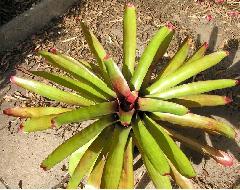
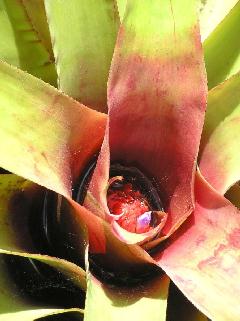
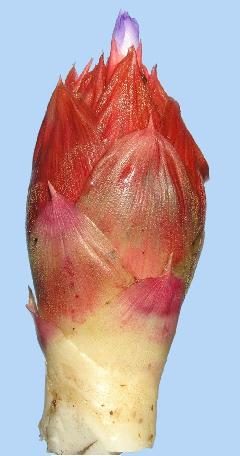
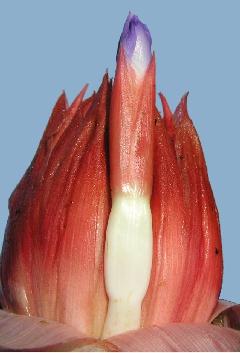
Neoregelia sanguinea Leme Selbyana 16(1):110-122. 1995
Type. Brazil: Espirito Santo State, Iuna, locality of Laranja da Terra, about 1,000 meters above sea level. Originally collected in July 20, 1987 by Roberto Kautsky 1013 and flowered in cultivation with E.M.C.Leme (no.1917), December 1993. (HB, holotype; SEL, isotype).
A N. macwilliamsii L. B. Smith et N. compacta (Mez) L. B. Smith, quibus affinis, laminis foliorum dense serrulatis, bracteis floriferis obtusis, sepalis obovatis, late acutis, 26 mm longis et basi 4 mm connatis differt.
PLANT propagating by short basal stolons.
LEAVES ca. 20 in number, spreading at anthesis, forming a broad crateriform rosette; LEAF SHEATHS broadly elliptic, 11 x 10 cm, densely brown-lepidote on both sides, purplish mainly adaxially;
LEAF BLADES sublinear, not narrowed at base, apex narrowly to broadly rounded and minutely apiculate, 17-25 x 5-6 cm, margins densely serrulate, spines ca. 0.5 mm long, glabrescent, green to purplish with green spots, the inner dark red toward the base; SCAPE ca. 3.5 cm long, ca. 1.5 cm in diameter;
SCAPE BRACTS subreniform, rounded and apiculate, densely serrulate, ca. 2.5 cm long, glabrescent, the upper ones (involucral bracts) broadly ovate, 4.5 x 3 cm, spinulose near the apex, slightly inflated, red with green spots.
INFLORESCENCE capitate, simple, subumbellate, sunk in the center of the rosette, ca. 4.5 cm long, ca. 3.5 cm in diameter, densely flowered;
FLORAL BRACTS sublinear, apex obtuse, slightly cucullate and inconspicuously apiculate, 4.5 x 1.5 cm, entire, ecarinate, membranaceous, reddish, slightly brown-lanate toward apex, equaling the sepals.
FLOWERS ca. 50 in number, ca. 5.5 cm long, pedicellate, pedicels 4.7 mm long, the outer ones complanate;
SEPALS asymmetric, obovate, broadly acute and inconspicuously apiculate, 26 x 11 mm, connate for ca. 4 mm, entire, ecarinate, reddish toward apex, sparsely brownlepidote inside;
PETALS subspathulate, obtuse, 37 x 8 mm, connate for ca. 18 mm at base, suberect at anthesis, white toward base and lilac at apex, bearing two 5 mm long callosities at the base of the lobes;
FILAMENTS adnate to the petal tube and free above it; Anthers sublinear, ca. 7 mm long, fixed at middle, base obtuse, apex apiculate; Stigma ca. 3.5 mm long, conduplicate-spiral, blades strongly contorted, margins shortly lacerate, white;
OVARY ellipsoid, ca. 16 mm long, ca. 6 mm in diameter, glabrous, white; Placentae apical; Ovules many, obtuse; Epigynous tube ca. 2 mm long.
Neoregelia sanguinea is closely related to N. macwilliamsii and N. compacta but can be distinguished from them by its densely serrulate leaf blades, obtuse floral bracts, and by its sepals, obovate, shorter, broadly acute and connate at base for 4 mm only. The name of this new ornamental species is a reference to the intense dark red color of its central leaves at anthesis.
It may not have the appeal of a variegated Neoregelia hybrid but certainly has a pedigree.
Deuterocohnia brevispicata by Derek Butcher
It all started when Lieselotte Hromadnik and her husband collected a plant near Chuquisaca at 1300m in Bolivia some 20 years ago. Lieselotte is known more for her Tillandsia collecting in the highlands of Bolivia and Peru but she had an interest in the pricklies too! This particular specimen was grown on at the Heidelberg Botanic Garden in Germany under the watchful eye of Werner Rauh. It flowered in captivity and was named Deuterocohnia brevispicata by Lieselotte and Werner jointly in 1988 in what is lovingly called Trop. Subtrop. Pflanz. I duly translated the description from German to English for my own records and there it stayed, just in case it may come in useful in the future.
In 2002, on one of the many trips that Len Colgan from Adelaide made to Germany to visit Renate Ehlers to increase his Tillandsia collection, he was able to visit Heidelberg Botanic Gardens and even acquired rare Tillandsia from there too. He must have really impressed them because shortly after he was sent seed which had previously been stored in a frozen state to increase their longevity of viability. One of the batches was called Deuterocohnia brevispicata. We don’t know much about freezing seed although we do know that in this case Timm Stolten had frozen the seed as an experiment in a regular freezer at –18C for nearly two years before sending some to Len. Non-frozen seed from this species are viable after 12 months so we did not learn much! However, we do know that the seed came from the type specimen where the same flower spike has flowered 3 times a year regularly for the last 18 years!
On receipt of the seed out came my records so we knew what the plant should look like but I was not going to wax lyrical because it was only seed we had. As is usual with generous Len, he spread the seed around growers in Australia (and Adelaide). We had little success but there were rumours that John Catlan and Genny Vauhkonen had succeeded but were they according to the name on the packet? We are growing seedlings from John but they are exceedingly slow. I had heard rumours that one of these plants was producing a long long flower spike and no sign of it flowering. So it was great to get photos in the Sept/Oct 2006 issue of Bromlink – The Goldcoast Group Newsletter – of the plant in flower.
I contacted the owner of the plant, Lyn Hall who supplied me with coloured photos. So here is the next part of the story. John Catlan got the seed in 2002 and, Ian and Lyn bought a small seedling in Oct 2004 because they wanted something different for their cactus and succulent rockery. Less than 2 years later it was in flower. We know that in every seed batch there are always one or two plants that grow much faster than the rest – was this one of them? Or is it just the fabled Queensland weather plus fertiliser? Lyn tells me no fertiliser and sandy soil so the only other option is that the plant likes free root room. Outside plantings are great but you must have plans to weed from time to time! Anyway, Lyn did not expect such a flowering phenomenon. Remember that the description said flowering to 1.2m and here the inflorescence was up to 2m long and bending towards the ground. With the aid of ropes and a nearby tree the flower stem was kept fairly erect. The flowering habit is odd to say the least although the name ‘brevispicata’ gives a hint but ‘strobilata’ may have been more descriptive.
Brevispicate means short spike which does not refer to the generally-called flower spike but to the short side branches. Strobilate means like a pine-cone and here you have a scape some 50cm long emerging before the first red ‘pinecone’ appears and every 10cm or so a new red ‘pinecone’ stretching to over 2 metres if you live on the Gold Coast.
Eventually from these 2.5 cm diam ‘pinecones’ flowers emerge where the petals form a bicoloured tube which is predominantly red but with a clear bright green tip. A colour combination only nature could think up!
Please remember not to remove the flower head because it will just flower again, again and again. The Germans want to know what magical climate you have on the Gold Coast because it takes them 10 years from seed to flowering. I have told them the secret is ‘hot air’ caused by bragging!!
I am told that John and Genny at Jacob’s Well have ‘hundreds’ of these plants if you are interested in something different by way of pricklies. But remember if you do come from down south in Australia you will have to wait a bit longer for flowering.